Asters with Heart-shaped Leaves

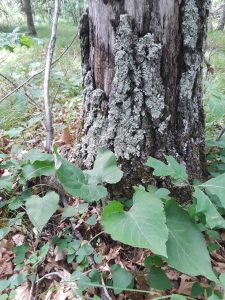
Eurybia macrophylla, also known as Big-leaf aster, is native to Minnesota and a ubiquitous sight on the forest floor of our woodlands. Starting in spring, the large, broad leaves of this plant carpet the forest understory preparing for the glorious autumn blooms we know will accompany us through the change from summer into autumn. Unlike many other asters, these basal leaves persist through flowering. Late summer into Fall, the flower’s purple petals decorate the forest, for this plant’s rhizomes allow it to spread into colonies. A member of the Asteraceae (Aster) family, the slender petals shoot from the yellow center in rays. Flowers range from 1/2″ to 1.25″ across, and from pale blue or lavender to nearly white in color. Lower leaves are large and heart-shaped. Leaves become smaller and rounder as the season progresses as they ascend the growing stem. The lowest leaves can be up to 8″ long and 6″ wide and grow from long stalks which clasp the stem. Given this plant’s name, leaf size is definitely a factor for ID compared to the other asters with heart-shaped leaves.
Pollinators love all asters for the abundant nectar and pollen they provide.
Several other species of asters with heart-shaped leaves abound in the forest. Here are a few for ID comparison:
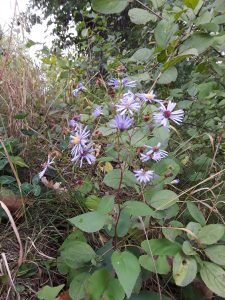
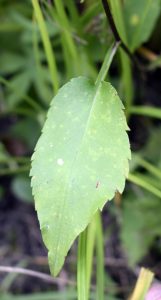
Lindley’s Aster (Symphyotrichum ciliolatum) has heart-shaped leaves that are much smaller than large-leaved aster — up to 5″ long and only 2″ wide. Leaf stalks are winged, and stems can be green or reddish. Stems are mostly smooth, a bit hairy nearer the top where 1″ to 1.5″, blue to lavender flowers are clustered. Leaves are smooth on their top sides and hairy only along the central rib on the underside.
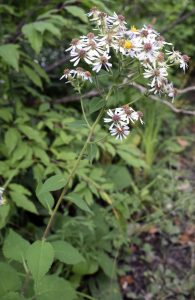
Drummond’s Aster (Symphyotrichum drummondii) has heart-shaped leaves about the same size as Lindley’s. Like Lindley’s, leaf stalks are winged and stems are hairless (or nearly so) on the lower part of the plant, but become much hairier in comparison towards the upper part of the plant. Leaves are not smooth, and have a rough texture on the top side as well as being densely hairy (short, soft) on the underside. Flowers are 3/4″ across with a wider color range than Lindley’s, from white to bright blue to lavender.

Blue Wood Aster (Symphyotrichum cordifolium) is another aster with heart-shaped leaves not profiled here because I have not personally come across it. Here is the link to its description on the Minnesota wildflowers website.
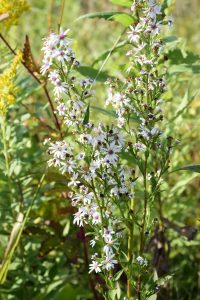
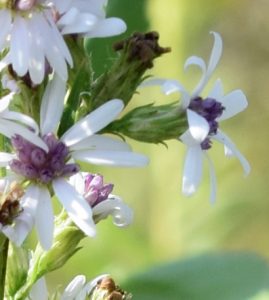
Arrow-leaf Aster (Symphyotrichum urophyllum) has lower leaf stalks with small, narrow wings, and white flowers clustered tightly, 1/2″ to 3/4″ across. The cylindrical cluster shapes of arrow-leaf aster are quite noticeable in comparison to the more open clusters of other aster species. Flower color also helps in this case to distinguish this from the other asters with heart-shaped leaves, because the others most often have blue/lavender rays as opposed to arrow-leaf’s white. Another distinguishing factor to ID this species is very apparent in the bracts of arrow-leaf asters (beneath the flowerhead). Arrow-leaf aster bracts (phyllaries) flare out as opposed to those of other aster species.
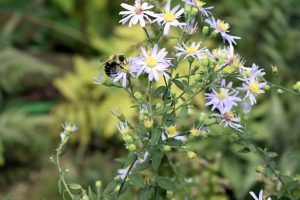
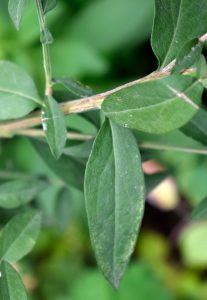 Short’s Aster (Symphyotrichum shortii) is rare growing wild in Minnesota; The photo shows a cultivated Short’s aster growing in a friend’s garden. The smooth-edged leaves are entire, meaning neither serrated nor indented around the margin or edges, which is a big identifier for this species. Having the trait of smooth-edged leaves is unlike most other asters with their toothy/serrated leaf edges.
Short’s Aster (Symphyotrichum shortii) is rare growing wild in Minnesota; The photo shows a cultivated Short’s aster growing in a friend’s garden. The smooth-edged leaves are entire, meaning neither serrated nor indented around the margin or edges, which is a big identifier for this species. Having the trait of smooth-edged leaves is unlike most other asters with their toothy/serrated leaf edges.
[Of the other blue/violet asters with heart-shaped leaves, Drummond’s Aster (Symphyotrichum drummondii) is consistently more densely hairy, Lindley’s Aster (S. ciliolatum) leaves are less strongly heart-shaped with broader wings on the stalks, Short’s Aster (S. shortii) has nearly toothless leaves that are proportionately narrower, Big-leaf Aster (Eurybia macrophylla) lower leaves are persistent through flowering, proportionately broader with clasping stalks. Arrowleaf Aster (S. urophyllum) has heart-shaped leaves with narrow wings on the lower stem, but has smaller white flowers arranged in tighter clusters.]
